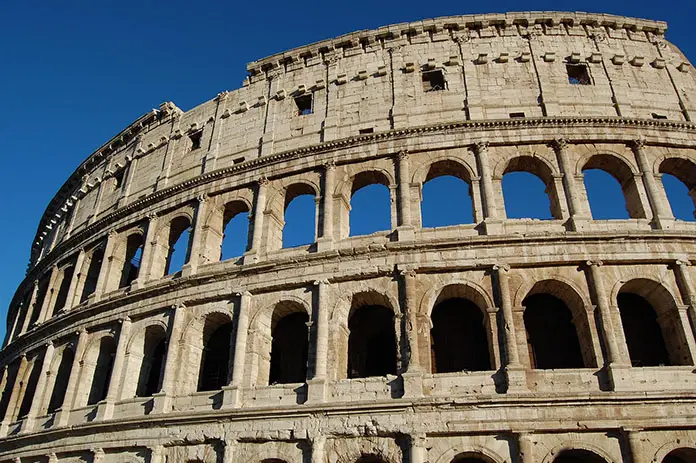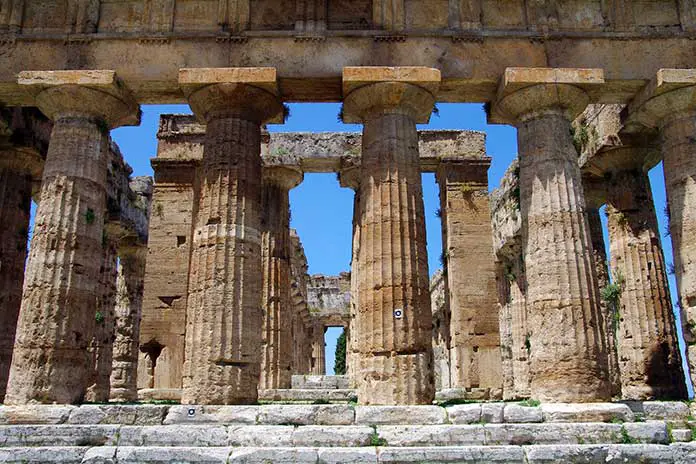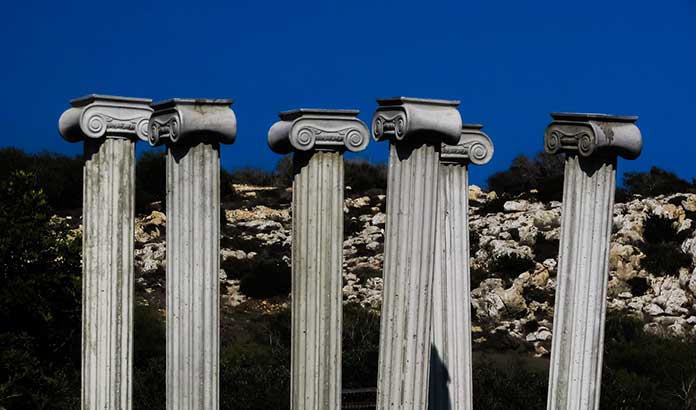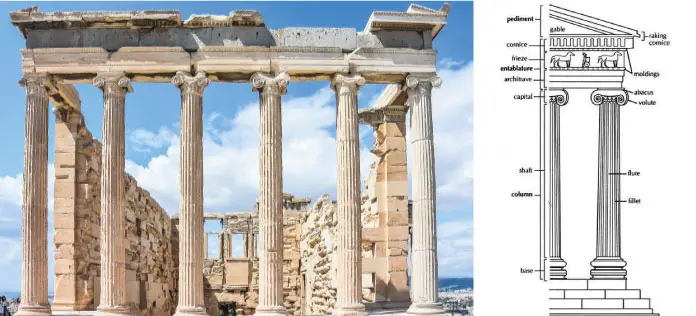An Ionic Column Can Be Distinguished by Its
Ionic guild together with doric and corinthian orders are the most important classical greek orders of architecture. It's regarded to has emerged in the 600s BC. Nike Apteros Temple, known every bit one of the offset of import examples of ionic order temples, was congenital in 427 BC.
Some temples were fully designing with the rules of ionic order. As for multi-storey structures, we often see ionic elements at the second floor. More often than not, the ground floor of these buildings have doric and the second floor has corinthian order components. Perhaps the most known of the multi floor buildings with mixed orders is Colosseum in Rome. Respectively, the basis floor is decorated with dor, the 1st floor is ionic and the 2nd floor is decorated with Corinthian style columns. However, these pillars have not whatever structural functions. The bearing elements enabling for the building to ascension so much are arches of the roman architecture.

In "De Architectura", Vitruvius said that ionic order architecture reflects the beauty of women. The author conveyed that when classic greek architects invent the ionic order, they have benefited grace, fineness, rate and fanciness of women body. In improver, according to him, doric order reflects the plain beauty of men body and as for corinth represents beauty of maiden's body.

Ionic structures which can be distinguished from doric club examples easily are frequently confused with corinthian buildings. Doric is so much simpler than others since it invented much earlier. Doric columns can mostly be distinguished easily by their no-groove body and unprocessed column capital. However, It'southward required to look under the hood for picking out corinth and ionic styles from each other. Let's we all together examine ionic order architectural elements closely.
Architectural Elements of Ionic Club
The key chemical element of classical greek architecture is the pillar. Greeks used to pillars as the bearing component of doric, ionic and corinthian orders. Beside this, they besides evaluated columns in terms of the aesthetic and make them the most importants of greek structures. And then, how to identify an ionian column?
Ionic column is thinner and taller than doric type. It looks much more graceful in dissimilarity with dumpy structure of doric columns. In generally, Ionic columns place upon pillar bases consisting of horizontal moldings or disks. Faces of these columns used to designed often with groove or rarely flat. According to "The Ten Books on Architecture", the number of grooves on pillars should be 24.

In that location is no entasis in the ionic social club column. The entasis principle has used mostly for the doric order with the aim of making optical illusions. With this manner, pillars ascension by getting thinner up, and they look overtall. In his book, Vitruvius narrates the classical orders down to the smallest particular, from the proportions of the columns to the drawing of the volutes by a compass. Thanks to these informations, West's great art movements like renaissance and neoclassicism had been fed on classical architecture quite.
Stylobat
Steps of stair, which is located in the archway of temples and mostly 3, are krepis. The start two step are chosen every bit stereobate, and the upmost one is stylobat. Stylobat is also the plate that acquit pillars and the ground floor. For this reason, it would non be incorrect to say that it is an entrance landing.
It was taken care in the pattern of stairs to ensure krepis number is odd. Past this ways, the right foot stepped on the beginning step volition besides be the pes stepping on the last step, namely the stylobate, Vitruvius says. In addition, he recommended that riser tiptop should exist between ix-x inch in terms of the comfort. Moreover, the width of the steps should exist in the range of 1.v-2 anxiety.
Pillar Base of operations in Ionic Society
In the ionic gild of greek architecture, columns are sit on pillar bases non on a stylobate. And then, this base transfers its load to the stylobate. Architects had arranged the length and width of the bases to be one.5 times the cavalcade thickness. Every bit for height of column base, it'south the one-half column bore. The molding that appears to be curved outward from these is called a torus. By and large, at that place is a narrower cross-sectioned intermediate element called scotia between the two toruses on the bases with lower and upper torus.

İonic Cavalcade Majuscule
The simplest mode of identify a classical greek order is looking at columns of the structures. These pillars relay disquisitional informations about what kinds of lodge were buildings designed with. As for the function of columns that vary almost from each others is their capital. Because, while the body of about of them differs simply as dimensionally, column capitals have more apparent features.
The matter that ensure us to distinguish the ionic column capital letter from other capitals and orders is volutes. There are volutes resembling a spiral flower, i on each side of the heading.
Since usage of volutes at corner pillars cause an aesthetic problem, these volutes differ. Because, the columns on the corner face both the forepart and side facades. For this reason, the problem was in the outward facing volute of the corner column. Should the outward-facing volute be turned to the front or to the side? As the solution, architects had idea a co-volute for both facade in the corner. Generally, this volute does not look at direct ahead, but in the middle of the two fronts. Furthermore, architects of the classical menstruum who want to solve the corner column problem recommended more unlike solutions.
Another element, the abacus, is the separating layer betwixt the column upper-case letter and the architrave. Although in that location is abacus in the ionic pillar capital, information technology was not used in the archaic period. Too, there was no frizes in the structures in that menstruation.
İonic Pediment and Entablature
In most of temple orders, we can see similar elements above the column heading. The most remarkable of these are the architrave consisting of horizontal moldings, the frieze with various drawings and statues, the cornice and the pediment on it. The pediment, which means fronton, was arranged in a triangular shape in the first times, yet it has undergone formal changes in the post-obit periods.
The Ionic order, about which I accept given a very brief information, is an architectural language that needs to be researched and studied much more. So much so that, with the enlightenment, European architects have investigate these three orders of the classical age, so started a rebirth in architecture with the renaissance. Undoubtedly, the about important source used for revealing the architectural tenets of the classical periods is the Vitruvius'due south work of ten books, which is estimated to was written in BC 25. I recommend you lot to read this cult book for getting unique informations about the classical architecture at first hand.
Source: https://archeetect.com/ionic-order/